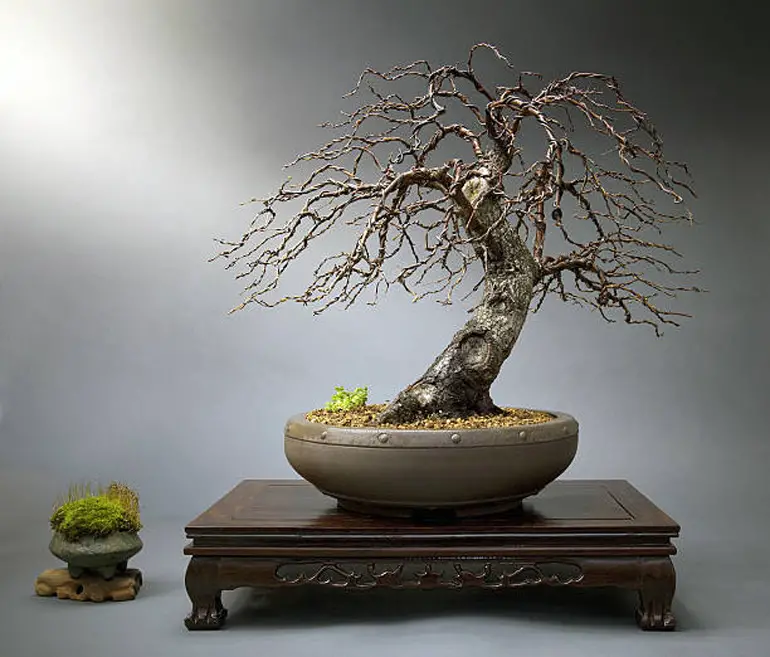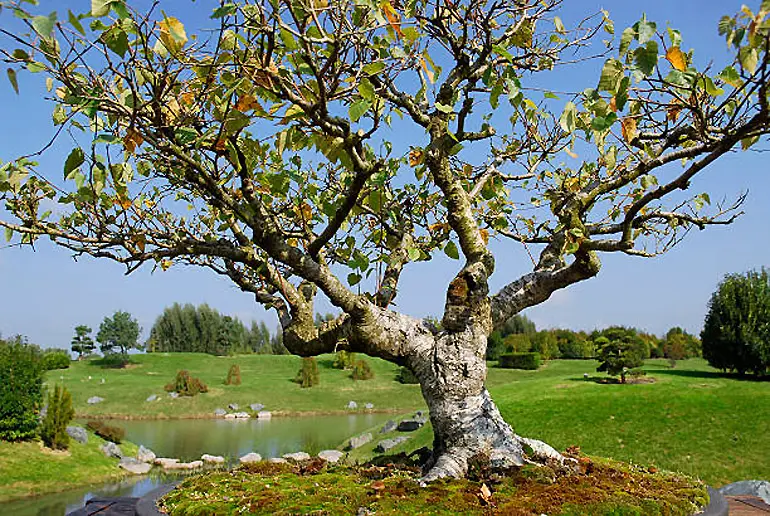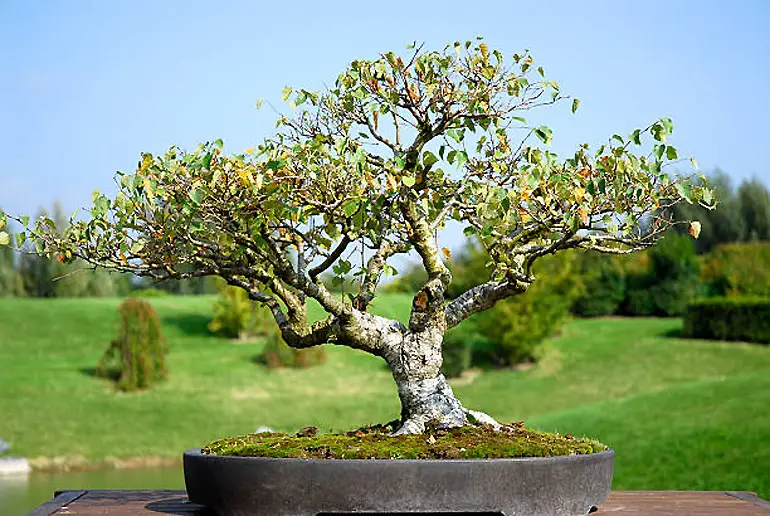Table of Contents
Although I and some other authors may have written comprehensively in the past about the various Bonsai trees there is, breaking down and demystifying the whole process involved, but after speaking to some Bonsai enthusiasts, they do tell me they still have a problem handling winter and some pests. Guess what I tell them every time? Go for Birch Bonsai tree!

The Birch Bonsai is one of the most sought-after deciduous trees used for Bonsai. They are renowned for their white bark and the diversity in the habitat they could be found: they can survive virtually everywhere whether it be moors, mountains, woodlands, and heathlands all over the Northern hemisphere. Plus they are among the most strongest and tolerant of all the deciduous tree species. Read this article for details on how best to cultivate this incredible conifer.
| Species | Betula Pendula |
| Average Height | 30 to 40 feet |
| Average Spread | 15 to 30 feet |
| Origin Countries | Europe and Asia |
| Flower Bloom Time | March to April |
| Flower Color | Yellowish brown |
| Type | Tree |
| Family | Betulaceae |
| Water | Moderate |
| Sunlight | Full sun |
| Maintenance | Hight |
Birch Bonsai History
Historically, few trees have always held significant meaning to lots of people around the globe: the Birch tree is one of these few. The Birch tree was believed to have contributed positively to the life of many for many years. The Birch tree can be split into different layers with varying thickness and resinous inner bark which makes it natural water-repellent and decay-resistant. Because of these special features, most people regard Birch trees as a highly versatile plant.
In the early years of Birch trees, there were used largely for shelter. They were used to make Tee-pees, Wigwams, and some other structures where they lived in. People at that time also used the inner bark of the paper Birch species to prevent their structures from flooding.
Birch trees were used for a wide range of purposes, but it was used extensively to make canoes. Over 100 years, has been widely used as a major means of transportation throughout the world. You can find Birch trees any place around the Nothern hemisphere all over the world. In all of these areas, Birch trees were used for making canoes.
Details that the idea of using the Birch trees for canoe making started within the circles of various groups from Siberia, or some Japanese group in the North American sub-region, or that the idea was simultaneously borne in all parts of the world out the need as at that time to find a means for water transportation remains sketchy that up to today, the origin of the use of Birch trees for canoe making is still shrouded in mystery.
Can Birch tree be Bonsai?
Yes, you can use Birch trees for Bonsai. The birch tree has virtually everything you may desire for in a Bonsai tree, plus they can grow well in a Bonsai pot.
The only limitation often encountered by Bonsai enthusiasts when making use of Birch trees is that they tend to lose most of their branches often. And there is no trace of any possible reason behind it. However, you shouldn’t be discouraged because they are fast-growing plants and the lost branches will be replaced in no time.
Birch Bonsai Scientific name
The scientific name of a Birch Bonsai is Betula Pendula
Birch Bonsai care requirement

Although Birch Bonsai is one of the toughest trees, however, there is a limit to their tolerance level. And that is why in this section, I will be providing useful insights on how you can treat your Birch Bonsai in the best possible way. Check details below.
Birch Bonsai temperature
Birch Bonsai tree is hardy to USDA zone 4 (-30 to -20°F) an average winter temperature level. Some species can even tolerate a colder temperature. They also preferred to be raised under full sunlight, save some of the species that prefer a partially shaded area.
Birch Bonsai fertilizer
You can apply any liquid or solid organic fertilizers to your Birch tree. Use solid fertilizers at least once every 4 weeks. Liquid fertilizers should be applied every week. Both should be applied during the growing season of the tree.
Warning: Do not apply liquid fertilizer to a Birch tree unless it is moisturized.
Birch Bonsai Pruning & wiring
Birch Bonsai responds pretty well to pruning, just be careful not to make large cuts on the trunk because doing so could cause the wood to rot. It can also cause a hollow trunk.
If you prefer that the branches and twigs of your tree are styled in a particular pattern, for instance, the changing shape, you will have to keep writing them anytime you notice new shoots are growing vertically. Remember what I told you earlier about Birch trees losing their branches too often?
The more reason why you have to be extremely careful about wiring is that most weak branches die during the wiring process. And that is why experts often recommend guy-wiring of the branches as one of the best methods for shaping the branches of a Birch tree.
Birch Bonsai repotting
You should repot your Birch Bonsai every 2 to 4 years. You can trim off about one-quarter of the root. Although Birch’s soil requirement is moderate, you must make sure the tree is watered often; therefore, you should use a soil mix that can retain lots of water so that the base of the tree does not dry out.
Birch Bonsai pests & diseases
Birch Bonsai are resilient to most pests and diseases, but they are more apt to be affected by insects like Birch leafminers bronze Birch borers, leaf diseases, as well as branch and trunk diseases. Check below for details about these pests.
Birch leafminers
Birch leafminers are the caterpillars of tiny wasps known as Black sawflies. The adult wasps have the habit of laying their eggs on fallen leaves laying around. When these eggs are hatched, they become leaf-eating caterpillars. As they feed on these leaves, they make pale turning by digging through the Birch leaves. These tunnels then turn brown causing the tree to drop dead leaves.
Although Birch leafminers don’t kill Birch trees, they distort their trance and weaken their resilience against bronze Birch borer infection. According to researchers from the University of California, they believe the best way to prevent Birch leafminer infestation is by planting Birch tree species like the River birch and the European Birch which are less likely to be vulnerable to the Birch leafminer invasion.
Borer pests
This insect is considered to be deadlier than the Birch leafminers because they can kill Birch trees. This insect digs deep into the bark of the Birch tree to eat the vascular tissue responsible for transporting nutrients throughout the tree system.
Anytime you notice the top leaves of your Birch tree are turning yellow, it is most likely the symptom of the borer pest invasion. This is because they are the furthest from the root which extracts nutrients from the soil, therefore, since the transport system is damaged, it will be hard for the tree to transfer nutrients from the root to the top.
Unfortunately, this infection cannot be controlled by any chemical; the only solution provided by Maryland Cooperative Extension is that the affected branches must be pruned to curb the spread of the diseases to another part of the tree.
Leaf Diseases
Fungal diseases caused by pathogens often lead to blotches, blisters, and leaf spots on the Birch Bonsai tree.
Cylindrosporium and septoria are known to cause tiny spots with no borderline: but Colletotrichum is more aggressive and creates wider spots with dark borderlines. Angular blotches are a result of Anthracnose diseases spaced by Pathogens like; Marssonina and Discula.
Maryland Cooperative Extention suggested that leaf Diseases on a matured Birch tree foes not require the use of pesticides. And as for young Birch trees, they recommend that one sprays infected trees with a preventive sulfur fungicide to help control further spread of the diseases.
Branch and trunk diseases
Pathogens like; Melanconium betulinum, Botryosphaeria species, and Nectria galligena cause Canker and Dieback diseases that affect the bark and the Cambium layers of the Birch Bonsai tree. Affected tissues expand and kill tissues in good conditions beneath the bark. Symptoms of this infection include the formation of knotty growth on the bark of the tree causing girdled stems or noticeable deadwood as a result of the splitting up of the bark.
Unfortunately, there are no known preventive chemicals. The only drastic step that can be taken is by ensuring proper health maintenance for your tree. The best way to do this is by making sure your Birch Bonsai is adequately provided with enough water and fertilizers. Also, all affected branches must be thoroughly pruned to curb the spread of the diseases.
Birch Bonsai soil
Although Birch Bonsai can tolerate dry soil, the best soil for the cultivation of a Birch Bonsai is the sand-loam soil that can retain enough water. This type of soil will prevent fertilizers from leaching away from the soil due to overwatering.
Birch Bonsai watering
Birch Bonsai usually require more water during their growing season, therefore, you must make sure they are adequately supplied with water during this period. If you live in a hot region, it is advisable to wet your Birch tree at least once a day for healthy growth. Most Bonsai lovers who live in hot regions will transfer their Bonsai tree to a shallow spot so that they can fill it up with water during mid, -summer.
During winter, your Birch Bonsai tree will require only a little watering. All you have to do is to ensure that the soil is slightly moist most of the time to prevent root rot due to dry soil. You can easily maintain a balance between overwatering and underwatering by feeling the soil with your finger. If it feels wet, do not water, but if it is dry, add water in moderation.
Birch Bonsai sunlight requirement
Bitch Bonsai loves to bask in the light of the day, therefore, take it outdoor under full sunlight. However, they should be shaded from full exposure to the mid-day sunlight if you leave in areas with hot climates. This becomes necessary because of their highly sensitive leaves which could burn under prolonged intense heat.
A typical Birch Bonsai tree needs the warmth of summer as well as the coldness of winter for healthy growth. However, you should equally prevent your Birch tree from overexposure to any temperature level cooler than 19.4°F that is also windy.
Birch Bonsai styles

There are many species of the Birch tree, but only a few which include; Paper Birch, Silver Birch, River Birch, Himalayan Birch, and Powny Birch are used for Bonsai. Although several other Birch species can be used for Bonsai, only a few listed above shall be detailedly explained. Check below for individual descriptions.
Paper Birch Bonsai
The paper Birch, also known as the White Birch or the Canoe birch originates from northern North America. It is a short-lived tree and is named for its fine white bark, which looks like paper layers when it peels from the trunk. It can grow up to 66 feet with a single trunk in the forest, but when grown as a Bonsai, it can be trimmed to the standard size and can grow multiple branches and trunks.
Silver Birch Bonsai
The silver Bonsai is a hardy delicious tree popularly grown as Bonsai because of its appealing aesthetic feature. It can be found in temperate regions most especially in Europe and Asia. Many refer to the silver Birch as a pioneer tree because it will survive conditions that could kill other plants and trees and would grow faster than most other trees. Its natural ability to survive under any condition makes it one of the best trees that can be used for Bonsai.
River Birch Bonsai
The River Birch Bonsai is a fast-growing plant that loves being shaded, it can grow multiple stems which is a highly coveted feature in the Bonsai world. It has an attractive exfoliating bark which is the common characteristic associated with almost all Birch species. It is also one of the most versatile species as it can survive under warm conditions and in soil with poor drainage.
Himalayan Birch Bonsai
The origin of the Himalayan Birch Bonsai can be traced back to the western Himalayan of Nepal as well as the northern region of India. The tree belongs to the Betulaceae family and also bears close ties with the family of beech and oak. The tree is mostly found in temperate regions throughout the world as well as the Northern Hemisphere. The tree is also popularly known as the Indian paper Birch, Himalayan silver Birch, Jacquemontii Birch e.t.c.
The Himalayan Birch can grow up to 66 ft tall in the forest and favors moderately wet, heavy clay soil, well-drained loamy but not a friend of wet soil.
Powny Birch Bonsai
The Powny Birch Bonsai is a small, scrawny tree that has tiny branches with paper-like bark. It grows well on damp soil, moorland, heathland as well as on mountainsides. Powny Birch can be easily identified with its upright growth. It has rounded leaves that grow on hairy stalks.
Birch Bonsai Indoor or Outdoor plant?
Another interesting fact about the Birch Bonsai tree is that they can be grown as both indoor and outdoor plants.
However, the Birch tree has several species with varying levels of temperature, sunlight, and tolerance level: therefore, you must be aware of the specific care requirement of the species you intend to keep. This will help you determine the best placement for your Birch tree.
How to grow Birch Bonsai indoor
It is very easy to grow Birch Bonsai indoors. The key issue here is how to provide your indoor Birch with adequate humidity, water, and light. The care requirement discussed in this article can guide you on how to adequately provide your Birch tree with all that is needed for healthy growth.
How to grow Birch Bonsai outdoor
The first step in growing a Birch Bonsai outdoors is determining whether the species of your choice can be grown outdoor. Once you’ve established the truth about that, then all you need to do is create enough space for your Birch tree in your garden and stick to the care requirement.
How much space does a Birch Bonsai need?
A Birch Bonsai tree needs a 3×3 column of free space of 6 blocks over the sapling to germinate, as well 5×5 layers without obstructing the upper 3 layers of its capper height.
How fast can Birch Bonsai grow?
Birch Bonsai is a fast-growing plant and you can have full growth within 3 weeks if raised in a conducive environment.
Do Birch Bonsai have flowers?
Yes, Birch Bonsai is a monoecious plant (I.e. they have both female and male flowers) so they have flowers. The flowers grow simultaneously with the new leaves in their growing season.
Is Birch Bonsai toxic to cats?
No, Birch Bonsai is not toxic to cats or any pet.
According to the report from the University of North Dakota, Birch Bonsai is can be safely ingested by pets because the tree is considered a good source of food for game animals, fur-bearing animals, and hoofed animals.
These animals would ear the twigs, leaves, and buds of birch trees without any symptoms of plant poisoning after consumption.
If you are searching for pet friendly bonsai, please kindly have a look at money tree bonsai, acer ginnala bonsai, pittosporum bonsai and baobab bonsai. These bonsai species are 100% safe to pets.
![Pittosporum Bonsai [Pittosporum Tobira]](https://www.bonsai-express.com/wp-content/uploads/2022/05/Pittosporum-Bonsai-365x200.jpg)
![Sorbus Bonsai [Sorbus Aucuparia]](https://www.bonsai-express.com/wp-content/uploads/2022/05/Sorbus-Bonsai-365x200.jpg)
![Tsuga Bonsai [Tsuga Canadensis]](https://www.bonsai-express.com/wp-content/uploads/2022/05/Tsuga-Bonsai-365x200.jpg)
![Tamarix Bonsai [Tamarix Ramosissima]](https://www.bonsai-express.com/wp-content/uploads/2022/05/Tamarix-Bonsai-365x200.jpg)